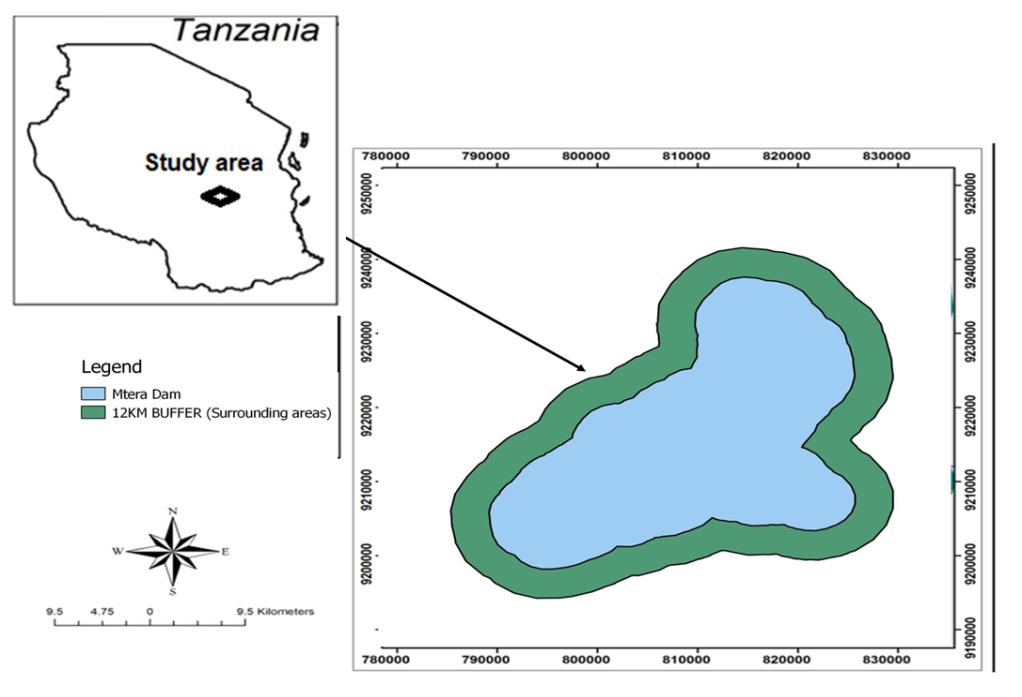IUCN/SSC Otter Specialist Group Bulletin

©IUCN/SCC Otter Specialist Group
Volume 38 Issue 2 (March 2021)
Citation: Bayo, M.J. and Rija, A.A. (2021). Distribution and Human-Otter Interaction in a Man-Made Mtera Dam: How Fishers perceive their Neighbour. IUCN Otter Spec. Group Bull. 38 (2): 95 - 105
Distribution and Human-Otter Interaction in a Man-Made Mtera Dam: How Fishers perceive their Neighbour
Martin J. Bayo*, and Alfan A. Rija
Department of Wildlife Management, Sokoine University of Agriculture, P.O. Box 3073, Chuo Kikuu, Morogoro, Tanzania.
* Corresponding Author: e-mail Josephmartin592@gmail.com
Received 14th May 2020, accepted 25th October 2020
Abstract: There is scarce information on the distribution of African clawless otter across many of its range habitats and how humans who mostly use similar resources perceive otters. This information gap precludes efforts to improve conservation of the otters especially in areas increasingly threatened by anthropogenic activities and habitat loss. We used local expert opinion assessment and field surveys as well as questionnaire to document the distribution of the African clawless otter and uncovered threats in the Mtera dam in central Tanzania. Our surveys detected otter presence in only 50% of the sites known by the local fishers in the area. More than 56% of the surveyed community were aware of the otter presence and reported four major threats faced by this carnivorous species including use of illegal fishing gears, overfishing, increased human population density that puts pressure on the land, water and fish resources and increased human habitation of the dam sides. These threats have the potential to drastically change the otter habitats and the ecosystem services offered by the dam with dire consequences to the human economy and food security. Improving conservation of the Mtera dam ecosystem is an increasing priority.
Keywords: Local perception; habitat threats; Mtera dam; otter hunting; species distribution
INTRODUCTION
The African clawless otter (Aonyx capensis) is a carnivorous small mammal species that inhabits semi-aquatic system where human activities are also common. Two (Aonyx. capensis and Hydrictis maculicollis) of the thirteen otter species known worldwide occur in lakes, rivers and wetlands in Tanzania (Foley et al. 2014). The populations of otters in many areas across Tanzania like many other countries, is less known due to limited studies. Information of otters from Tanzania is perhaps known from as few as five studies conducted in Lake Victoria by Kruuk and Goudswaard (1990), Reed-Smith et al. (2014), Amulike et al. (2013) and Stevens (2011) and recently by de Lucca et al. (2018) in southern Tanzania. There is no available information on the distribution of otters in other areas of Tanzania, despite the availability of many seemingly suitable habitats - a potential problem of conservation concerns for this predatory species. Elsewhere, studies have shown that otters across their range state are increasingly faced with threats from human persecution and loss of their habitats (Václavíková et al., 2011; Fonseca and Marmontel, 2011; Ergete et al 2018; Akpona et al., 2015; Andarge et al., 2018). Other threats to otters include increased exploitation of their food base, accidental killing in nylon fishing nets, (Kruuk and Goudswaard, 1990), trapping for fur (Serfass et al., 2017), medicinal extraction for fetish as well expansion of agriculture in their habitat range (Rowe-Rowe, 1992; Václavíková et al., 2011; De Luca et al., 2018). These threats have led to most (i.e. 12 of the 13 species) otter species designated as threatened or endangered on the IUCN red list book (Jacques et al., 2015).
Conflicts arising from interactions between people and wild animals influence the future survival of many wild mammal species (Rija, 2017). Lack of awareness and species knowledge by local residents can threaten species survival through persecution, retaliatory killing, hunting or destruction of species habitats (Drew, 2005; Kideghesho et al., 2013). In most cases, the main cause of conflict appears to be the local people’s perception of damage caused by otters to nylons nets together with a perception of prey depletion (fish, crabs and prawns) (Fonseca and Marmontel, 2012; Andarge et al., 2018). Like other animals, otters utilize habitat even those found outside protected areas. Hence, across the species’ distributional range, non-charismatic and yet unprotected species such as the African clawless otter in Tanzania is likely to be exposed to various threat levels (Reed-Smith et al., 2014; Rija, 2017).
Although not well known by the general public, this mammal species is partially known by the fishermen in aspects that affect their livelihood such as feeding on netted fishes that would otherwise be available for the human consumption (Stevens, 2011; Václavíková et al., 2011; Amulike et al., 2013). This has always been the source of consequential killing of otters by the fishers during fishing occasions (Amulike et al., 2013; Andarge et al., 2018). Thus, understanding the knowledge of local people on the species they regularly interact with and how they perceive it may provide insights into the designing or improving of species conservation plans in the Mtera dam. This is particularly important especially during this time when the population of the clawless otter is continually decreasing with very little data on the presence and status of this species in its natural range habitats (Jacques et al., 2015). The current study was conducted to fill this information gap and to provide data for the African clawless otter inhabiting an increasingly contested Mtera dam ecosystem in central Tanzania. The aims of this study were; (i) to understand and document the current distribution of the African clawless otter in the dam ecosystem using local expert opinion and ground survey, and (ii) to assess the perception among humans about otters and dam use in order to further deduce conservation threats faced by the otter.
METHODS
Study area
Mtera dam is an impounded water dam along the Ruaha and Kisigo rivers located in central Tanzania (Lat 7°08′10.3″S and Long 35°59′12.6″E) between Dodoma and Iringa regions (Fig. 1). The dam measures 56 km long and 15 km wide and is used for hydropower generation (Yawson et al., 2003a). The dam is located in a semi- arid area receiving about 400 mm rainfall per year during November through to April (Yawson et al., 2003b).Temperatures range from 20 oC to 30 oC which provide suitable conditions for a spectacular wildlife species that range from large (e.g. Hippopotamus) to small aquatic mammals, e.g. the African clawless otter. Other wildlife species inhabiting the dam ecosystem include, crocodile, fish, birds and invertebrates. Plant life in this ecosystem is characteristic aquatic and terrestrial and some is riverine. The water dam is patched with some creeping species particularly Glyceria maxima, water hyacinth and water lilies. The banks on the other hand is grown with native tree species including Adansonia digitata, Acacia tortilis and Commiphora species which are characteristic of dry savanna landscapes. The soil is sandy and clay that supports agricultural activities around the dam.
The Mtera dam serves a large and growing needs of the surrounding human populations and is one of the hubs for generating hydropower that feeds electricity into the national power grid. The human population has grown by almost 350% over a decade (NBS, 2010; NBS, 2013) and looks set to increase further due to some pull factors related to the resources available such as the dam for fishing and fertile soil for agriculture and also due to the climate change- related stresses (Kideghesho et al., 2013). Most inhabitants are engaged in fishing from the dam and some in occasional crop farming and livestock grazing along the rivers. The farming and fish curing activities have over time degraded vegetation cover in the ecosystem and are cited to be causing siltation in the Mtera dam (Yawson et al., 2006). Siltation affects the habitat and food base of the carnivorous African clawless otter that inhabits the dam.
Data collection and analysis
In order to assess the occurrence of otters in the area, we first conducted expert opinion assessment among a local fisher community who regularly use the dam and potentially encounter the otter. This method is appropriate in assessing relative abundance of some rare species and has been used to assess other wild mammal abundance in hunting terrestrial system (van der Hoeven et al., 2004). To verify the type of otter species found in the study area, we used the Sub-Saharan Otter standard ID sheet from African otter network (AON). The sheet has three coloured images of otters i.e. African clawless otter, spotted necked otter and water mongoose and was attached to the questionnaires to allow local experts to identify the animals present in our study area. The target respondents were asked to identify the species based on their experience of wht they know of the animal in question, choosing one of the images of animals presented to them. Further, to map where the otter occurs in the dam ecosystem, and to confirm information collected from the local experts, we conducted a boat survey (10 km) and 3 km of walk transect along the dam banks (covering 50 meters wide off shore), to ground-truth and record presence or absence of the otter as suggested by the local experts. During survey, otter distribution and species ID was documented by recording animal spraints recognized for their size and shape and also as ‘latrine’ depending on whether the scats were found together (De Luca et al. 2018). The survey was carried out both during day (to look for otters and signs of their presence) and night (to look for active individuals) using night vision googles. A total of 24 man-hours per transect for 5 days during the night and 2 days during daytime was used when conducting the ground walk transect.
Further, to understand how the local human population perceives otter presence in the area, a questionnaire survey with 150 respondents from six villages was conducted. The surveyed villages and respondents were selected deliberately, based on proximity, access and occupation in the target area (Kothari, 2012; Etikan et al., 2016). A simple random sampling was used to obtain a sample of the population, mainly fishers and crop growers, for the survey. The questionnaire had several questions concerning whether a respondent has ever seen an otter before in the area, main activities engaged in, types of fishing gear (for fishers) and type of crop farming system (for agrarians), any problems with otters in their daily life activities, how they generally perceived the otter and what do they do to mitigate otter-associated problems.
The collected information was analysed mostly descriptively and information from local expert opinion assessment and surveys was processed using GIS tools - mainly plotting maps to display the distribution of otters.
RESULTS AND DISCUSSON
Distribution of African Clawless Otter in the Mtera Dam
Local experts identified ten sites thought to be occupied by the otter in the Mtera dam ecosystem (Fig. 2). These sites were inside the dam, but a few were outside the water. Our survey confirmed otters in only five of the mentioned sites thought to have otters (Fig. 3).
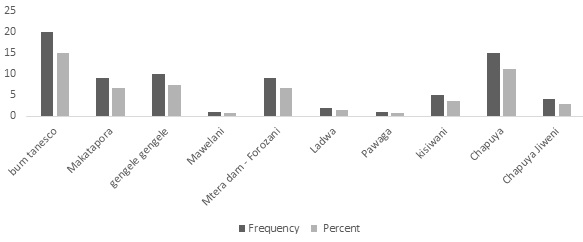
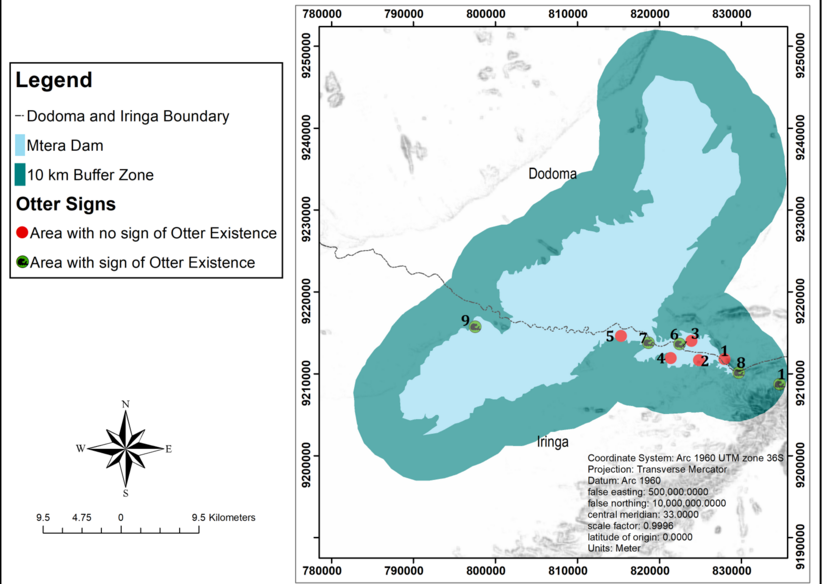
The information collected through local expert opinion assessment was useful in helping the search process during actual field surveys. Although the survey was able to confirm only about 50% of the suggested sites for otters, this may not invalidate the knowledge from the local experts. This is because fishers and crop growers have lived the areas for most of their life, conducting activities that potentially lead to encountering with the otters, thus they are the most knowledgeable about the system. Human activities such as fishing directly lead to interaction between fisher and otter because they both depend on the same resource (i.e. fish) for food. For example, local experts were able to clearly point out otter territories because these same sites were the targets for the fishers to set the fishing nets. Not detecting otters in all the sites on the other hand may have been due to the short time spent in surveys which probably did not coincide with the peak activity of the otters. Therefore, more search effort could, probably, have increased chances for sighting the otter in the target sites. Our use of local expert opinion is not uncommon approach in conservation studies. In Cameroon, van der Hoeven et al. (2004) used local expert assessment to estimate density of wildlife in forest habitats. This method was rapid and saved time and money, and thus has been advocated for use especially in animal assessment where detection is potentially low (van der Hoeven et al., 2004). Our target species is nocturnal and rarely comes out for feeding during daytime, thus the use of fishers during local expert opinion assessment was appropriate as they have a great chance of interacting with the species during the fishing activities.
Our boat and transect walk surveys revealed otter existence was restricted to only a few areas. We detected six individuals of African clawless otter during boat surveys and several scats of roundish shape or egg-chop like shape. The scats were mostly dominated by fish scales and fins (Table 1).
An alternative explanation to our detection of otters from only 50% of the sites is that some of the suggested sites could be used less by the otters, perhaps due to deterioration of the habitat quality in the dam. During both questionnaire and transect surveys, our field observations recorded considerable stream bank agricultural activities, litter pollution and scattered growing water weeds in the dam (Fig 4 - panel photos of litter, water weeds and farms at the dam banks). Supporting these observations, the local communities and some dam authorities mentioned several problems including increased dam siltation and overfishing as potential threats to the habitats and the survival of the African clawless otter.
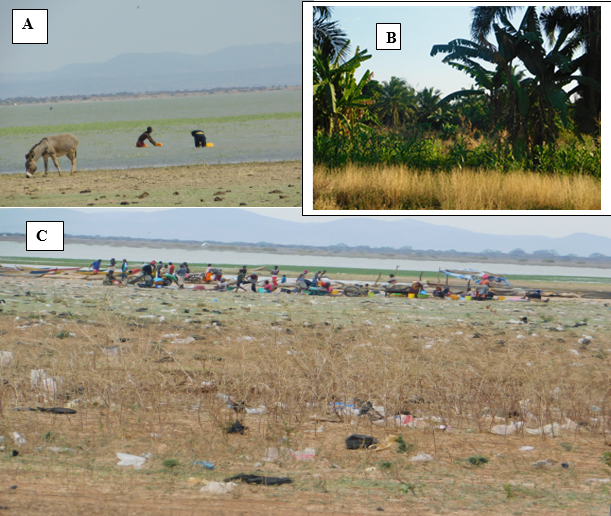
Human perception of and threats to otters in the dam
The question of human perception of otters in the study area revealed various responses. About 56% of respondents (N=140) replied that they knew about otter presence in the area and about 28% of the local communities had directly interacted with otters through hunting otters for meat and body parts for fetish (Table 2). Also, humans interacted with otters during fishing as they competed for similar fish food resources, and this interaction was perceived to be a substantial potential source of human-otter conflict as otters sometimes got entangled in fishing nets and were killed as a result by the fishers. Asking the types of threats that people thought negatively affected otter population in the area, several scores were given (Table 2). Four threats were recognized and highly ranked including use of illegal fishing gears, overfishing, human population increase in Mtera and increased human habitation of the dam sides (Fig. 5). Other threats that were perceived to be affecting the otter population were increased water pollution, otter hunting and expanding agriculture.
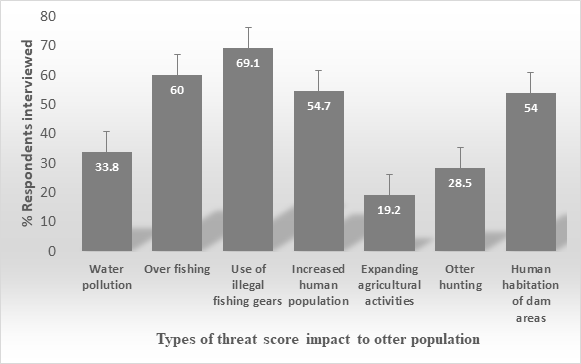
Understanding human perception of a species is an important avenue for assessing the conservation status of a species and potential threats to it in a particular area. Our finding that more than 50% of the surveyed human population were aware of the presence of otter in the area is encouraging, as this may suggest that any conservation efforts for otters that involve awareness raising may be conducted with relative ease. This argument stems from the fact that if local communities already know about a species and its importance, they are likely to align well with conservation measures (Kideghesho et al., 2013)..
Furthermore, the local perception of the existing threats and their severity to the otter population is important information for any conservation improvement plan. However, the use of illegal fishing gear and perceived overfishing are of high concern for the survival and conservation of otters in the area. Illegal use of unsustainable fishing gear, such as fish seine nets and poison, remove massive amounts of the fish population, reducing fish survival and recruitment, and directly diminishing the food base for the otters. Reduced fish stock in the dam may further exacerbate fish resource competition between the fishers and otters. Furthermore, the hunting of otters for meat and body parts directly reduces the population in the area, while increased human habitation along the dam and expanding agricultural activities add silt into the dam. Siltation has the potential to significantly reduce the depth of the dam, reducing the breeding habitat for fish and thus the potential food resources available for the otter population. Altogether, these threats will have far reaching impacts on the long-term survival of this least conserved aquatic carnivore in Tanzania.
The implications of these data are far reaching, both for the conservation of the otter and its habitat, and for human food security. Firstly, the distribution of the African clawless otter in the Mtera dam ecosystem appears to be declining, as pointed out by the surveyed local fisher community, probably due to the identified threats in the area. While our search efforts found that about 50% of all the sites originally known by the local communities to have otters were now negative, we are not sure whether additional sampling effort could have added more positive sites. We are tempted to argue that the range of otter has indeed declined. However, we caution that longer time research is needed to confirm our initial observations. Also, we suggest that long-term monitoring of otter population is urgently needed in the area for planning to alleviate potential drastic decline of the population and imminent local extirpation resulting from increasing anthropogenic activities. Use of illegal fishing gear and overfishing fall within the dam management capability and could be regulated through law enforcement and introduction of some zoning schemes to regulate potential overfishing impacts. It is recommended that the dam management authority under Tanzania Electricity Supply Corporation (TANESCO), in collaboration with the local government fishery authority in the area, should set up a monitoring unit that would oversee conservation efforts in the area. Such a unit would be responsible for monitoring human activities in the area such as agriculture, water use, hunting of otter and other wild animals and the sprawl of human habitation impacts near the dam.
Secondly, the use of the resources in the dam ecosystem is important for ensuring food security for the growing human population in the area. The local communities heavily depend on the land, water and fish resources for producing food crops, drinking water and fish protein food. As urbanization and human population growth increase in the area, pressures on these resources will increase and will likely squeeze the population of the African clawless otters towards local extirpation (Rija et al., 2014). The fish landed from the Mtera dam is traded in many regions of central and eastern Tanzania especially in Dodoma, Morogoro and Dar es Salaam, thus contributing substantially to the local economy and food security of many people in these regions. Human population increasing in this region will increase fish demand, thus increasing fishing pressure in the Mtera dam. This will further reduce the food base for the clawless otter. There is, thus, an urgent need for some measures to be put in place to ensure sustainability of the resources used. One way to make this happen is to raise awareness about this species and conservation of the habitats among a wider community, including conservation agencies, e.g. Tanzania Wildlife Authority (TAWA), and policy makers, e.g. the Wildlife Division in Tanzania, so that informed decisions on the conservation of the whole dam watershed ecosystem can be made. Reaching the wider community could be possible through popular media such as local newspapers, which have been found to be an important avenue for communicating biodiversity and conservation information locally (Rija and Kideghesho, 2020). Striking this balance will also ensure longer-term survival of the African clawless otter which depends on the water and fish resources in the increasingly contested Mtera dam.
Acknowledgements: This study benefited financial support from the Rufford Small Grant Foundation through Grant # 25815-1 to the first author. We thank Jan Reed Smith for providing us with Sub Saharan otter’s standard ID sheet as aid to guide the surveyed respondents to correctly ID the clawless otter. Dr. John Mgonja, Dr. Sayuni Mariki and Dr. Nsajigwa Mbije for their technical assistance during data collection. Two field assistants, Madata Mlinago and Joel Pesha for their help during data collection in the field and anonymous reviewers for the comments to this manuscript.
REFERENCES
Akpona, A.H., Djagoun, C.A.M.S., Harrington, L.A., Kabré, A.T., Mensah, G.A., Sinsin, B. (2015). Conflict between spotted-necked Otters and fishermen in Hlan River, Benin. Journal for Nature Conservation, 27: 63-71.
Amulike, B., Stevens, S.S., Serfass, T.L. (2013). Enhancing tourist opportunities to view spotted-necked otters (Lutra maculicollis) at Rubondo Island National Park: can the a priori location of latrines simplify identifying best viewing areas? Afr. J. Ecol 51 :609-617.
Andarge, E., Wube, T., Balakrishnan, M., Serfass, T.L. (2018). Fishermen knowledge and conflict with African clawless otter in and around Lake Tana, Ethiopia. Afr. J. Ecol 56: 409-313
De Luca, D.W., Dewas, M., Mpunga, N., Machaga, S.J., Phillipps, G.P. (2018). The conservation status of otters in Southwest Tanzania. IUCN Otter Specialist Group Bulletin, 35 (3): 134-147.
Drew, J.A. (2005). Use of Traditional Ecological Knowledge in Marine Conservation. Conservation Biology, 19: 1286-1293. https://doi.org/10.1111/j.1523-1739.2005.00158.x
Ergete, E.A. Hailemariam, T.W., Balakrishnan, M., Serfass, T.L. (2018). Fishermen knowledge and conflict with African Clawless Otters in and around Lake Tana, Ethiopia. Afr. J. Ecol, 56: 409-413.
Etikan, I., Musa, S.A. Alkassim, R.S. (2016). Comparison of convenience sampling and purposive sampling. American Journal of Theoretical and Applied Statistics, 5: 1-4.
Foley, C., Foley, L., Lobora, A., De Luca, D., Msuha, M., Davenport, T.R., Durant, S.M. (2014). A field guide to the larger mammals of Tanzania (Vol. 90). Princeton University Press.
Fonseca, V., Marmontel, M. (2011). Local knowledge and conflicts with Otters in western Brazilian Amazon: a preliminary report. IUCN Otter Spec. Group Bulletin, 28(B): 64 - 68.
Jacques H., Reed-Smith J., Somers M. (2015). Aonyx capensis. The IUCN Red List of Threatened Species 2015. http://dx.doi.org/10.2305/IUCN.UK.2015- 2. RLTS.T1793A21938767.en
Kideghesho, J.R., Rija, A.A., Mwamende, K.A., Selemani, I.S. (2013). Emerging issues and challenges in conservation of biodiversity in the rangelands of Tanzania. Nature Conservation 6: 1-29.
Kothari, C.R. (2012). Research methodology: An introduction. Research Methodology: Methods and Techniques, 9, 418. Chicago
Kruuk H., Goudswaard, P.C. (1990). Effects of changes in fish populations in Lake Victoria on the food of Otters (Lutra maculicollis Schinz) and (Aonyx capensis Lichtenstein). Afr. J. Ecol. 28: 322-329.
National Bureau of Statistics (NBS) [Tanzania]. (2010). Population projections. (2010). Dar es Salaam,Tanzania: NBS.
National Bureau of Statistics (NBS) and Office of Chief Government Statistician (OCGS). (2013). 2012 Population and Housing Census: Population Distribution by Administrative Units; Key Findings. Dar es Salaam, Tanzania: NBS and OCGS
Reed-Smith, J, T. Serfass, T. Kihudu, and M. Mussa. (2014). Preliminary report on the behavior of spotted-necked otter (Lutra maculicollis, Lichtenstein, 1835) living in a lentic ecosystem. Zoo Biology 33: 121-130.
Rija, A.A. (2017). Spatial Pattern of Illegal Activities and the Impact on Wildlife Populations in Protected Areas in the Serengeti Ecosystem. PhD thesis, University of York, U.K. http://etheses.whiterose.ac.uk/id/eprint/20276
Rija, AA. Said, A., Mwamende, K.A. Hassan, S.N., Madoffe, S.S. (2014). Urban sprawl and species movement may decimate natural plant diversity in an Afro-tropical city. Biodiversity and Conservation 23(4): 963-978.
Rija, A.A., Kideghesho, J.R. (2020). The Coverage of Biodiversity Conservation Issues in Local Newspapers and Its Role in Enhancing Conservation Awareness in Tanzania: An Analysis of Two News Outlets. Archiv Zool Stud., 3: 013
Rowe-Rowe, D.T. (1992). Survey of South African otters in a freshwater habitat, using sign. South African Journal of Wildlife Research. 22: 49-55.
Serfass, T.L., Wright, L., Pearce, K., Duplaix, N. (2017). Animal welfare issues pertaining to the trapping of otters for research, conservation, and fur. In Marine Mammal Welfare (pp. 543-571). Springer, Cham.
Stevens, S.S. (2011). Flagship species, tourism, and support for Rubondo Island National Park, Tanzania.
Václavíková, M., Václavík, T., Kostkan, V. (2011). Otters vs. fishermen: Stakeholders’ perceptions of Otter predation and damage compensation in the Czech Republic. Journal for Nature Conservation, 19: 95-102.
Van der Hoeven, C.A., de Boer, W.F., Prins, H.H. (2004). Pooling local expert opinions for estimating mammal densities in tropical rainforests. Journal for nature conservation, 12: 193-204.
Yawson, D.K., Kashaigili, J.J., Kachroo, R.K., Mtalo, F.W. (2003). Modelling the Mtera Kidatu Reservoir System to improve Integrated Water Resources Management. International Conference on Hydropower (Hydro Africa 2003), 17th-19th Nov. 2003, Arusha, Tanzania.
Yawson, D.K., Kachroo, R.K., Kashaigili, J.J. (2003). Failure of the Mtera-Kidatu reservoir system in the Early 1990s. Paper Presented at Ruaha+10 Seminar, 11 & 12 December 2003, Morogoro, Tanzania. 12 pp. (paper) + 3 pp. (powerpoint)
Yawson, D.K., Kongo, V.M., Kachroo, R.K. (2006). Impact assessment of Mtera and Kidatu reservoirs on the annual maximum floods at Stiegler's Gorge of the Rufiji River in Tanzania. Water International, 31: 100-108.
Zlatanova, D.P. Popova, E.D. (2018). Biodiversity estimates from different camera trap surveys: a case study from Osogovo Mt., Bulgaria. Nature Conservation Research. 3: 13-25.
Resumé: Distribution e Interaction entre l’Homme et la Loutre à Joues Blanches (Aonyx capensis) au Barrage Artificiel de Mtera: Comment les Pêcheurs perçoivent-ils leur Voisin ?
Il existe peu d'informations sur la répartition de la loutre à joues blanches (Aonyx capensis) dans plusieurs de ses habitats de prédilection et sur la façon dont l’homme, qui utilise principalement des ressources similaires, perçoit la loutre. Ce manque d'informations nuit aux efforts visant à améliorer la protection des loutres, en particulier dans les zones de plus en plus menacées par les activités anthropiques et la régression de l’habitat. Nous avons utilisé une enquête d'opinion d'experts locaux et des relevés de terrain ainsi qu'un questionnaire destiné évaluer la distribution de la loutre à joues blanches et mettre en évidence les menaces qui pèsent sur le barrage de Mtera, situé dans centre de la Tanzanie. Nos enquêtes ont mis en évidence la présence de loutres dans seulement 50% des sites connus par les pêcheurs locaux de la région. Plus de 56% de la communauté étudiée étaient au courant de la présence de la loutre et ont signalé quatre menaces majeures auxquelles cette espèce carnivore est confrontée, notamment par l'utilisation d'engins de pêche illégaux, la surpêche, l'augmentation de la densité de la population humaine qui exerce une pression sur les terres, l'eau et les ressources halieutiques et une augmentation de l’urbanisation sur les rives du barrage. Ces menaces peuvent potentiellement changer de manière radicale les habitats de la loutre et les bienfaits de l’écosystème que procure le barrage, avec des conséquences désastreuses pour l'économie humaine et la sécurité alimentaire. L'amélioration de la conservation de l'écosystème du barrage de Mtera est une priorité croissante.
Revenez au dessus
Resumen: Distribución e Interacción Humanos-Nutrias en la Represa Mtera, Tanzania: Cómo Perciben los Pescadores a su Vecino
Existe muy poca información sobre la nutria sin garras Africana a lo largo de su rango de distribución y de sus hábitats preferidos además de cómo los humanos perciben a esta especie. Esta carencia de información previene esfuerzos de conservación de las nutrias que están cada día mas amenazadas de extinción debido a la persecución humana y la pérdida de hábitat. En este estudio usamos la opinión de expertos y recorridos en campo así como cuestionarios para documentar la distribución de la nutria sin garras Africana en la región de la presa Mtera en centro de Tanzania. Nuestros recorridos en campo detectaron la nutria en solamente 50% de los sitios conocidos por los pescadores del área. Mas del 56 % de los encuestados habían visto las nutrias y conocían su presencia en la región. Los encuestados reportaron cuatro amenazas mayores para esta especie de carnívoro, el uso de artes de pesca ilegales, la sobrepesca, un incremento en la densidad humana que presiona los recursos del agua, la tierra y la pesca y un incremento en uso de los lados de la presa como áreas urbanas. Esas amenazas tiene el potencial de cambiar drásticamente el hábitat que utiliza la nutria y modificar los servicios ecosistémicos ofrecidos por la presa con consecuencias para la economía humana y la seguridad alimentaria. Mejorara la conservación del ecosistema de la presa Mtera es una prioridad
Vuelva a la tapa
